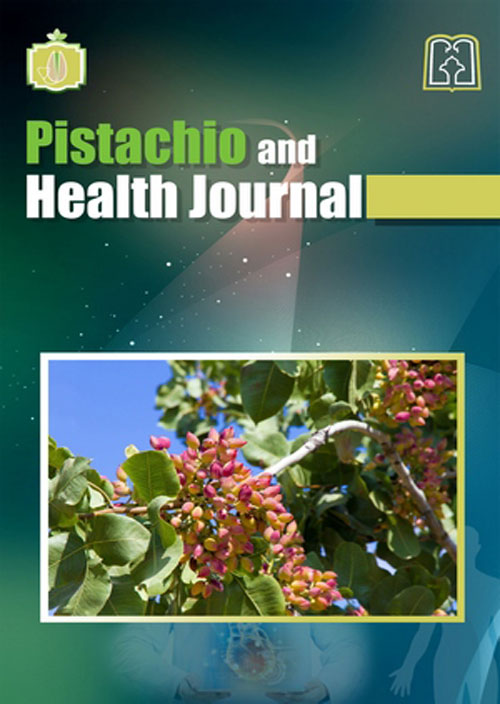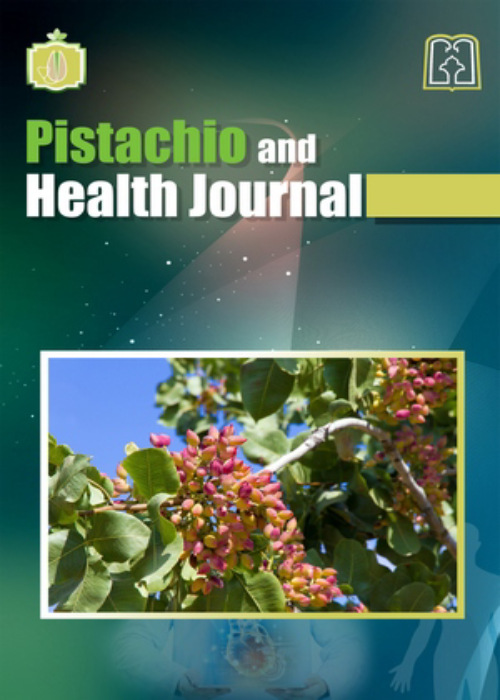فهرست مطالب

Pistachio and Health Journal
Volume:4 Issue: 2, Spring 2021
- تاریخ انتشار: 1400/04/15
- تعداد عناوین: 8
-
Pages 4-12Introduction
In traditional medicines, almost all Asian countries, particularly Iran, consider plants for therputical purposes. This study assessed the impact of the Baneh Fruits (Pistacia Atlantica) hydroethanolic extract on certain enzymes and biochemical elements in rats.
Materials and Methods200 and 400 mg/kg of the extract were given orally once a day for 28 days to two rat groups, each with eight animals. The control group was given only distilled water. Under chloroform anesthesia, the rats fasted overnight were dissected on the 29th day. Then, their blood was directly taken from their hearts. In the next step, some liver biochemical parameters including aspartate aminotransferase (AST), alanine aminotransferase (ALT), gamma-glutamyl transferase (GGT), total bilirubin, biochemical parameters of kidney including blood urea nitrogen (BUN), creatinine, urea, and metabolic parameters including fasting plasma glucose (FPG), cholesterol, triglycerides, and high-density lipoprotein cholesterol (HDL-C) were measured in the collected blood serums.
ResultsThe plant fruit extract decreased significantly the serum concentrations of triglycerides, cholesterol, AST, creatinine, and total bilirubin in the two doses (p<0.05). The 200 mg/kg dose decreased BUN and urea concentrations and increased HDL-C concentration significantly (p<0.05). While only a dose of 400mg/kg of the extract decreased the GGT level significantly (p<0.05).
ConclusionsThe hypocholesterolemic, hypotriglyceridemic, and hypo bilirubinemic impact of the extract coupled with the decreased AST activity indicated that the Baneh fruit may be beneficial in controlling hypertriglyceridemia and hyper-cholesterolemia.
Keywords: Baneh, biochemical parameters, Pistacia Atlantica, traditional medicine -
Pages 13-27Introduction
SWOT analysis is one of the strategic tools for corresponding internal strengths and weaknesses to external opportunities and threats. According to this model, an appropriate strategy maximizes strengths and opportunities and minimizes weaknesses and threats.
Materials and MethodsThe present study attempts to evaluate the strengths, weaknesses, opportunities, and threats in the Iranian pistachio industry.
ResultsA group strategies have been extracted by analyzing the strengths, weaknesses, and threats in the Iranian pistachio industry and reviewing the strategies and policies of the base models. The strategies that have been extracted include: developing management and planning, developing advertisement and marketing systems, promoting knowledge and technology in the Iranian pistachio industry, attracting national and international support and sponsorship, increasing productivity, developing an efficient monitoring, evaluation and control system.
ConclusionThe evaluation of SWOT matrix indicated the weakness of internal factors and the large volume of health threats in Iranian pistachios. Moreover, the matrix has also reported that the optimal strategies should be defensive. In such conditions, a strategy is required to be adopted that, depending on the weaknesses, reduces or eliminates the damage caused by the threats ahead. To increase consumer awareness and health, a corrective approach is required to be adopted in the structure of the current health status of Iranian pistachios (especially for smallholders).
Keywords: Pistachio, Analysis, strategy -
Pages 28-39Background
Currently, due to the scarcity of water resources and the water shortage crisis, the preservation of contamination of water resources is of particular importance. Nitrate is one of the most hazardous pollutants in aquatic environments, which leads to many health and environmental problems. Thus, finding environmentally friendly solutions to remove nitrate from water sources is essential. This study examined hard pistachio shells as a raw material for the preparation of activated carbon and their use as an adsorbent.
Materials and MethodsThe experimental laboratory study explored factors affecting the absorption process including initial nitrate concentration, pH, absorption dosage, and reaction time on nitrate removal efficiency. The structural properties of the adsorbent were investigated by field emission scanning electron microscopy and the point of zero charge (pHpzc). Finally, the adsorption kinetics and isotherms were investigated.
ResultsUnder optimize conditions, including initial nitrate concentration of 50 mg/L, adsorbent dosage of 0.2 g/L, pH equal to 5, and reaction time of 30 min, activated carbon can remove 99.4% of nitrate. The maximum adsorbent capacity was 211.6 mg/g. Nitrate removal follows quadratic kinetics and the Langmuir isotherm.
ConclusionThe surface adsorption process using activated carbon prepared from hard pistachio shells can lead to the effective management of pistachio shells and has a significant efficiency in the removal of nitrates with high concentrations.
Keywords: Adsorption, Nitrate, Contaminated Water, Activated carbon, Hard Pistachio Shells, Isotherm, Kinetics -
Pages 40-51Background
Women are sensitized to stress-related psychiatric disorders, such as depression and anxiety. Several studies have shown that follicular development and ovarian reserve are reduced after chronic stress.
ObjectivesIn this experimental study, the effect of oral consumption of pistachio oil was evaluated on mice models undergoing chronic unprintable mild stress.
Material and Methods6–8-week-old female C57BL/6J mice were randomly divided into 4 groups: one control and three experimental groups (n= 8). Animals in experimental groups (I, II, and III groups) were exposed to a variety of chronic unpredictable stress for 4 weeks. Then, the mice in I and II groups were fed orally 1 and 4 ml/kg/day pistachio oil for 4 weeks, respectively. Animals in the III and control groups received tab water. Forced swimming test (FST), sucrose preference test (SPT), and tail suspension test (TST) were performed to evaluate behavioral despair and hedonic level in mice. Their ovaries were analyzed for the number and diameter of primordial, primary, secondary, and antral follicles.
ResultsFST showed depressive-like behavior to be increased in stress groups compared with the control. According to SPT, greater data deviation was observed in the control mice compared to the experimental groups (P = 0.036). Follicle cell numbers showed a significant decrease in the I and III groups compared to the control (p = 0.034). In addition, there was a remarkable decreasing trend in the diameter of secondary and antral follicles in the I and III groups (p = 0.039).
ConclusionThis study demonstrates that pistachio has protective impacts on unpredictable chronic mild stress in the mice model. Therefore, pistachio could be a potential medical supplement for improving follicular development and ovarian reserve.
Keywords: Pistacia vera, Stress, Follicular development, Mice -
The effects of pistachio hydroalcoholic extract on stroke in permanent middle cerebral artery occlusion in ovariectomized female ratsPages 52-64Background
Phytoestrogens, found in abundance in the extracts of oilseeds such as pistachios, have estrogen-like and anti-inflammatory effects. This study investigated the effects of pistachio kernel extract on stroke in ovariectomized rats.
Materials and MethodsThis study was conducted on four groups of female rats weighing 200-250 g. The groups included the control group and three groups treated with pistachio hydroalcoholic extracts (100, 250, and 500 mg/kg) (n = 10 per group). One week after ovariectomy and its confirmation (via vaginal smear examination), the extracts were gavaged for four weeks and at the end of the fourth week, stroke was induced by closing the middle cerebral artery. Infarct volume and cerebral edema were measured 72 hours after brain extraction and staining with tetrazolium chloride. Neurological disorders were measured using the Bederson ranking system and sensory-motor disorders were measured via two behavioral tests including the sticky test and hanging test (hanging the animal from a thin wire string). Furthermore, cerebral edema was measured by determining the percentage of water in the affected hemisphere compared to the intact hemisphere.
ResultsPistachio extract (especially at a dose of 500 mg/kg) reduced the risk of infarct volume (p <0.0001) and cerebral edema (p <0.0001) in the treatment groups compared to the animals in the control group. Pistachio extract also improved neurological disorders and sensorimotor function.
ConclusionAccording to its anti-inflammatory, antimicrobial, antioxidant, and estrogen-like properties, pistachio extract improves the stroke complications in ovariectomized female rats.
Keywords: stroke, Ovariectomy, Pistachio, Rats -
The effect of sulfur, wollastonite, biotite, zeolite, graphite, perlite, and feldspar on oviposition and egg hatching of common pistachio psylla Agonoscena pistaciae Burckhardt & Lauterer (Hem.: Psyllidae) in orchard conditionsPages 65-74Background
Common pistachio psylla, Agonoscena pistaciae Burckhardt & Lauterer (Hem.: Psyllidae), is one of the most important pests of pistachio trees in Iran. Considering the risks of overusing synthetic chemical pesticides, it seems that the use of mineral compounds as insecticides is one of the ways to reduce the residual amount of dangerous toxins.
Materials and MethodsIn this study, mineral compounds (sulfur, wollastonite, biotite, zeolite, graphite, perlite and feldspar) were used to investigate the oviposition rate of adult insects as well as egg hatching.
ResultsThe results showed that the leaves treated with feldspar (0.01 ± 0.00), zeolite (0.07 ± 0.001) and perlite (0.97 ± 0.021) at a concentration of 50,000 mg/l were reported to have the greatest decrease in terms of the oviposition rate of the pest in the first year. The results of oviposition rate in the second year indicated that the leaves treated with zeolite and biotite had a significant decrease and increase respectively, compared to the control group. Studies also showed that zeolite treatment could not make any changes in the process of egg hatching.
ConclusionGiven the favorable effect of feldspar, zeolite and perlite in reducing oviposition rate, foliar application of pistachio trees with these compounds can control the population of pistachio psylla.
Keywords: common pistachio psylla, mineral compounds, ovipositionegg, hatching rate -
An overview of effective detoxification methods for aflatoxin-contaminated pistachioPages 75-93Introduction
Aflatoxins are a group of fungal secondary metabolites generally produced by Aspergillus flavus and A. Parasiticus. The Aflatoxin contamination especially occurs during processing stages in dried fruits, after harvesting. Aflatoxin contamination of Iranian pistachios has caused an export reduction in the last years. Aflatoxins contribute to replacing thymidine with guanine at the codon 249 of P53 (tumor suppressor gene) in the human genome; this mutation in the DNA could cause liver cancer.
Materials and MethodsMethods to manage the reduction of aflatoxin contamination has great importance; the most effective treatments, including chemical (ozone and citric acid) and physical (UV-C and gamma radiation), are reviewed in this paper
ResultsIn ozone (O3) treatments in which the sensitivity of aflatoxin B1 and G1 is more than aflatoxin B2 and G2, under UV-C radiation, the degradation of aflatoxin B2 and G2 to is higher than aflatoxin B1 and G1. Acidic and alkaline substances also are utilized to eliminate aflatoxins in some products.
ConclusionUse of acids along with other detoxification methods such as ozone, UV- C radiation, and …, will be more effective to degrade aflatoxins in pistachio nuts.
Keywords: Aflatoxin, Detoxification, Citric acid, Nuts, Ozone, UV-C


